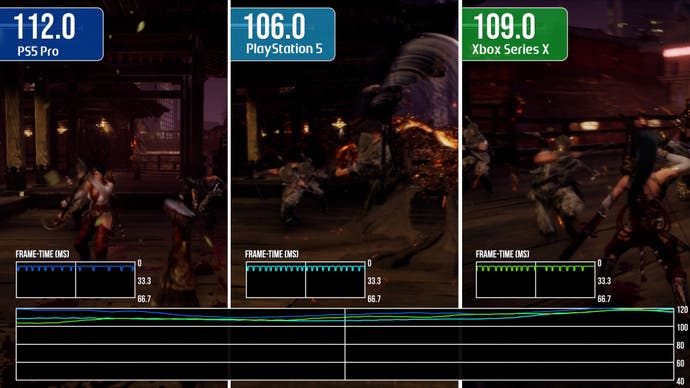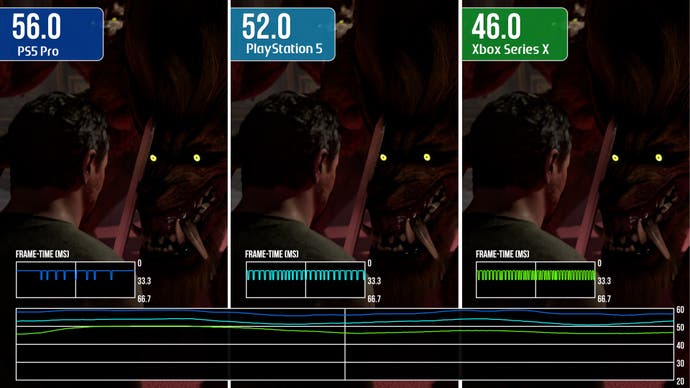Unreal Engine 5 is one of the most resource-intensive game engines out there: just reaching 60 frames per second while utilising Lumen global illumination and Nanite micro-geometry is a serious challenge for developers. With that in mind, it perhaps comes as no surprise to see that Team Ninja opted for ‘master ninja difficulty’ in remaking Ninja Gaiden 2. Not only are UE5’s cutting-edge features deployed in Ninja Gaiden 2 Black, the developers are choosing to target 120fps on a console. Did the studio achieve its target or is it just a step too far for current generation hardware?
This is just one facet of Team Ninja’s latest project. Ninja Gaiden 2 Black marks the return of the second modern entry in the Ninja Gaiden franchise. As the final Team Ninja game helmed by Tomonobu Itagaki, the original Xbox 360 version kicked players in the teeth and left them begging for more. It’s a beloved yet tough-as-nails action game that just happened to be riddled with technical and balance issues. Even so, with its insane enemy counts, extreme dismemberment system and intense speed, it rewards those who stick with it. However, things got weird with Ninja Gaiden Sigma 2. Released initially for PlayStation 3, Sigma 2 would serve as the basis for each new release going forward. It’s a more polished game with more content but at the same time, it has its own issues: enemy numbers are reduced, damage and HP values are tweaked and the glorious showers of blood removed.
Which brings us to Ninja Gaiden 2 Black, shadow dropped after the Xbox Developer Direct. Let’s just say that it’s a curious release. Fundamentally, this is a release like Bluepoint’s work on games such as Demon’s Souls and Shadow of the Colossus: a visual remake that combines the original engine running original gameplay, working within Unreal Engine 5. But even that’s a somewhat simplistic view of the situation.This isn’t just a prettier version of Ninja Gaiden Sigma 2. Instead, it feels as if the development team went in and pulled elements from all versions of Ninja Gaiden 2 to create a completely new version of the game. One change is the return of the limb severing system and the litres of blood that went missing in Sigma. The new system is extremely over the top with every slice of the Dragon Sword filling the air with showers of blood that then pool on the floor and, eventually, dry up.
The original iteration of this system tied into the combat – enemies in the Xbox 360 game appear in larger numbers but can be killed faster or at least their limbs chopped off creating a different type of threat. In Sigma, enemies all take more damage but there are fewer of them at any given point. It’s difficult to say for sure but it seems like the new release walks somewhere in between the two: overall, there are fewer enemies than Ninja Gaiden 2 on Xbox 360, but somewhat more than the body count in Sigma on PS3.
The new game also includes the easier bow and arrow system and various changes to level designs. The extra stages included in Sigma 2 are here but not all of the bosses, such as the statue boss in the first stage. The key is that the development team clearly put in the work here to rebalance the game as they saw fit which is commendable.
Visual comparisons with the Xbox 360 original are intriguing. By and large, I think the new version of the game looks significantly better – but there are areas where the original Xbox 360 vision stands strong. The intro cutscene’s skybox subjectively looks better to me than the new game’s equivalent – even though Team Ninja has turned a 2D texture into actual 3D work. Other changes include completing changing the mood of the second level by changing the time of day, for example. That said, the rest of the rendering quality is largely boosted. Character models look significantly better, I think, aside from, perhaps, the artefacts visible in the hair. Overall geometry is massively improved, as you would expect with Nanite in the picture.
What makes this so interesting is that much like Namco’s Tekken 8, the gameplay itself is handled by a different underlying engine – in this case Ninja Gaiden Sigma 2 – but all rendering is handled by Unreal Engine 5. What this means in practice is that the game plays authentically but benefits from beautiful new lighting thanks to Lumen while Nanite ensures no visible LOD pop-up during gameplay.
All console versions of the game feature software Lumen and Nanite including Xbox Series S. When playing on PS5, PS5 Pro and Xbox Series X, players also have the choice between 60fps and 120fps using dynamic resolution scaling and Epic’s TSR upscaler. PS5, PS5 Pro and Xbox Series X all target a 4K upsampled output in the 60fps mode though the internal resolution is obviously lower. The 120fps mode instead targets 1080p, which is also true of Series S which only has one mode – 1080p60.
The results are interesting, but this is a game that, in some ways, demonstrates the limitations of modern upsampling and temporal anti-aliasing. With a high input resolution, the results are excellent – especially on PS5 Pro which is noticeably sharper than any other version in action. The problems show up with the lower resolution modes and especially with Xbox Series S which has fewer frames to work with. Image quality on Series S is so bad that I would almost consider it worse than the Xbox 360 original. Basically, there’s just not enough native pixel data to work with and thus, when combined with the fast motion, the results can border on the hideous. The 120fps mode has similar issues but due to the higher number of frames to upsample from, the results are less egregious.
Otherwise, the visuals are nearly identical – the 60fps modes on PS5, PS5 Pro and Series X all look basically the same. The 120fps mode and the Series S version has a reduction in terms of draw distance of non-Nanite geometry and things like shadows which draw in close to the camera. Can the game handle 120fps? Well, in terms of image quality, just barely – the sacrifices required here are significant and image quality is rather poor on a large 4K display.
In terms of performance, the PS5 Pro version runs fastest with PS5 slightly behind on average and Xbox Series X at the bottom. Unfortunately, no version is able to fully hold 120fps and the frame-rate is highly variable. The problem here is that the game does not play nicely with frame-rates that fail to lock to 30, 60 or 120fps. Anything in between presents with judder regardless of whether you have VRR enabled or not. It’s just an issue with how this game seems to work. So, I can’t recommend the 120fps mode at all on consoles: the hit to image quality and the unstable performance just isn’t that desirable.
When running at 60fps, however, I think the results are excellent. PS5, PS5 Pro and Xbox Series X all do a wonderful job locking to 60fps during normal gameplay while offering good image quality. It also runs significantly better than any of the original releases of the game. The PS5 Pro version especially feels good thanks to a slight boost in image quality, though it’s not enhanced beyond this, which could be seen as a disappointment. Xbox Series S? You get 60fps but it doesn’t look pretty.
The PC version is interesting and by virtue of the sheer horsepower potentially available, it can be the best-looking version of the bunch. The options menu is robust and you have many more upsampling options and the ability to play at native res. The Xbox Store version initially was missing DLSS and XeSS – which isn’t acceptable – but thankfully the studio added those features post-launch.


One of the curious new features on PC is an additional ‘ray tracing’ option in the menu. Lumen as seen on console is a software-based form of ray tracing and that is the default setting on PC but the RT option invokes hardware-accelerated Lumen – but the results are a little strange with many objects missing from the BHV structure used to calculate RT effects. With this in mind, I’d stick to software Lumen – but I do hope that Team Ninja addresses the hardware alternative. Another nitpick with the PC version is the poor implementation of frame-generation. Both DLSS and FSR variants are available but neither works properly owing to visible judder that eliminates the whole point of the feature. This might be related to the game’s need to perfectly lock to 30, 60 or 120fps and the latency mitigation features mean the target frame-rate falls just below 120fps on my 120Hz panel. I’m not entirely sure but was unable to use either of them smoothly.
The reason this is important is because the game seems to be quite CPU heavy – I’m using a now mid-range 12900K and 120 fps is simply off the table with this CPU, requiring me to cap the game at 60fps to achieve smooth, consistent play. There’s also mild stutters on first run and various other minor hiccups. I can’t say that it’s a bad PC version, necessarily, but it’s certainly not where I would like it to be.
Right now, my overall feeling on Ninja Gaiden 2 Black is positive – but with a hint of disappointment. The visual upgrades are largely welcome and I prefer this to any version of Sigma 2 but there’s still room for improvement both with game balance and technical performance. Still, I’m thrilled that Ninja Gaiden 2 has made a return and if you’ve not played it before, I highly recommend giving it a shot. Furthermore, for those wanting physical copies of your games, the PS5 version will be receiving an Asian disc release sometime soon, so keep that in mind.










Add comment